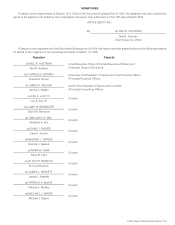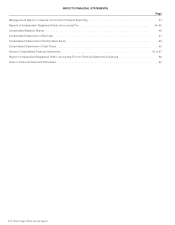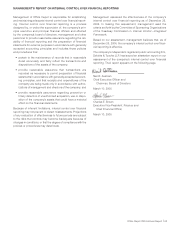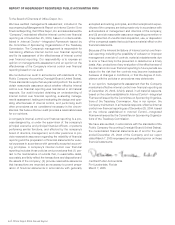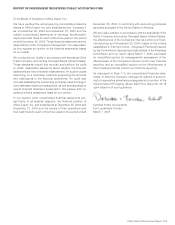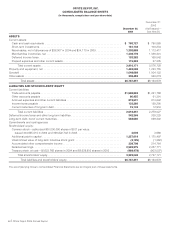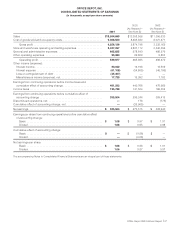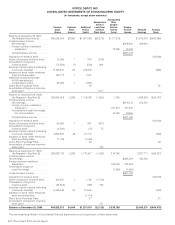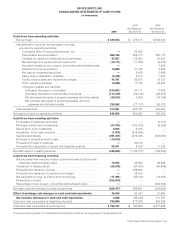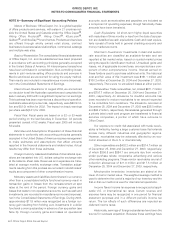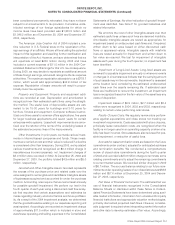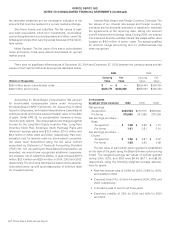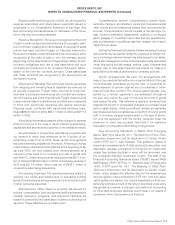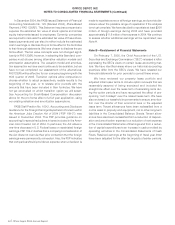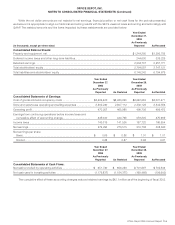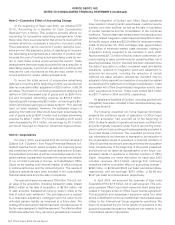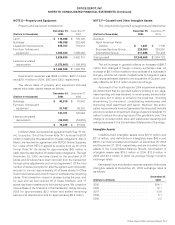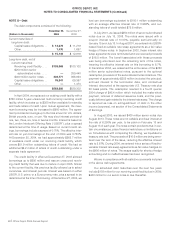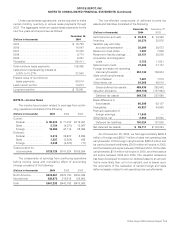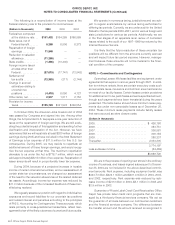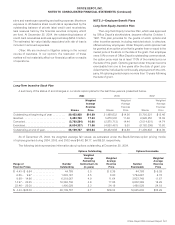Office Depot 2004 Annual Report Download - page 53
Download and view the complete annual report
Please find page 53 of the 2004 Office Depot annual report below. You can navigate through the pages in the report by either clicking on the pages listed below, or by using the keyword search tool below to find specific information within the annual report.Office Depot 2004 Annual Report |51
been considered permanently reinvested, they have not been
subject to an incremental U.S. tax provision. Cumulative undis-
tributed earnings of our foreign subsidiaries for which no
income taxes have been provided was $1,203.5 million and
$1,046.2 million as of December 25, 2004 and December 27,
2003, respectively.
The American Jobs Creation Act of 2004 included a one-
time reduction in U.S. Federal taxes on the repatriation of for-
eign earnings of an affiliate. We are still evaluating the potential
impact of this legislation and awaiting further clarification and
interpretation of the Act. However, we have determined that we
will repatriate at least $200 million during 2005 and have
included a current expense of $11.5 million in the 2004 Con-
solidated Statement of Earnings for this U.S. tax consequence.
During 2005, we may decide to repatriate an additional amount
of these foreign earnings, and would recognize the tax expense
at that time. The maximum repatriation allowable to us is $778.7
million, which would add approximately $32.9 million of tax
expense. Repatriation of lesser amounts will result in propor-
tionally lower tax expense.
Property and Equipment: Property and equipment addi-
tions are recorded at cost. Depreciation and amortization is
recognized over their estimated useful lives using the straight-
line method. The useful lives of depreciable assets are esti-
mated to be 15-30 years for buildings and 3-10 years for
furniture, fixtures and equipment. Computer software is amor-
tized over three years for common office applications, five years
for larger business applications and seven years for certain
enterprise-wide systems. Leasehold improvements are amor-
tized over the shorter of the terms of the underlying leases or
the estimated economic lives of the improvements.
Other Investments: In prior years, we made various invest-
ments in Internet-based companies and funds. These invest-
ments are carried at cost and their value is reduced if a decline
is considered other than temporary. During 2003, we liquidated
various investments and recognized an $8.4 million charge in
miscellaneous income (expense), net. Impairment charges of
$3.0 million were recorded in 2002. At December 25, 2004 and
December 27, 2003, the portfolio totaled $4.9 million and $5.0
million, respectively.
Goodwill and Other Intangible Assets: Goodwill represents
the excess of the purchase price and related costs over the
value assigned to net tangible and identifiable intangible assets
of businesses acquired and accounted for under the purchase
method. Accounting rules require that we test at least annually
for possible goodwill impairment. We perform our test in the
fourth quarter of each year using a discounted cash flow analy-
sis that requires that certain assumptions and estimates be
made regarding industry economic factors and future profitabil-
ity. As a result of the 2004 impairment analysis, we determined
that the goodwill balance existing in our Japanese reporting unit
was impaired. Accordingly, we recorded an impairment charge
of approximately $11.5 million which is included in store and
warehouse operating and selling expenses in the Consolidated
Statements of Earnings. No other indication of goodwill impair-
ment was identified. See Note F for goodwill balances and
related information.
We amortize the cost of other intangible assets over their
estimated useful lives unless such lives are deemed indefinite.
Amortizable intangible assets are tested as appropriate for
impairment based on undiscounted cash flows and, if impaired,
written down to fair value based on either discounted cash
flows or appraised values. Intangible assets with indefinite
lives are tested annually for impairment and written down to
fair value as required. We test for impairment of intangible
assets each year during the fourth quarter; no impairment has
been identified.
Impairment of Long-Lived Assets: Long-lived assets are
reviewed for possible impairment annually or whenever events
or changes in circumstances indicate that the carrying amount
of such assets may not be recoverable. Impairment is assessed
at the location level, considering the estimated undiscounted
cash flows over the asset’s remaining life. If estimated cash
flows are insufficient to recover the investment, an impairment
loss is recognized based on the fair value of the asset less any
costs of disposition.
Impairment losses of $3.9 million, $2.7 million and $5.4
million were recognized in 2004, 2003 and 2002, respectively,
relating to certain under-performing retail stores.
Facility Closure Costs: We regularly review store perform-
ance against expectations and close stores not meeting our
investment requirements. Costs associated with store closures,
principally lease cancellation costs, are recognized when the
facility is no longer used in an operating capacity or when a lia-
bility has been incurred. Store assets are also reviewed for pos-
sible impairment, or reduction of useful lives.
Accruals for lease termination costs are based on the future
commitments under contract, adjusted for anticipated sublease
and termination benefits. We conducted a comprehensive
review of closed store commitments during the fourth quarter
of 2003 and recorded a $23.9 million charge to terminate some
existing commitments and to adjust the remaining commitments
to current market values. We recorded similar charges in 2002
of $6.7 million. The accrued balance relating to our future com-
mitments under operating leases of our closed stores was $58.8
million and $57.6 million at December 25, 2004 and Decem-
ber 27, 2003, respectively.
Fair Value of Financial Instruments: The estimated fair val-
ues of financial instruments recognized in the Consolidated
Balance Sheets or disclosed within these Notes to Consoli-
dated Financial Statements have been determined using avail-
able market information, information from unrelated third party
financial institutions and appropriate valuation methodologies,
primarily discounted projected cash flows. However, consider-
able judgment is required when interpreting market information
and other data to develop estimates of fair value. Accordingly,
OFFICE DEPOT, INC.
NOTES TO CONSOLIDATED FINANCIAL STATEMENTS (Continued)


